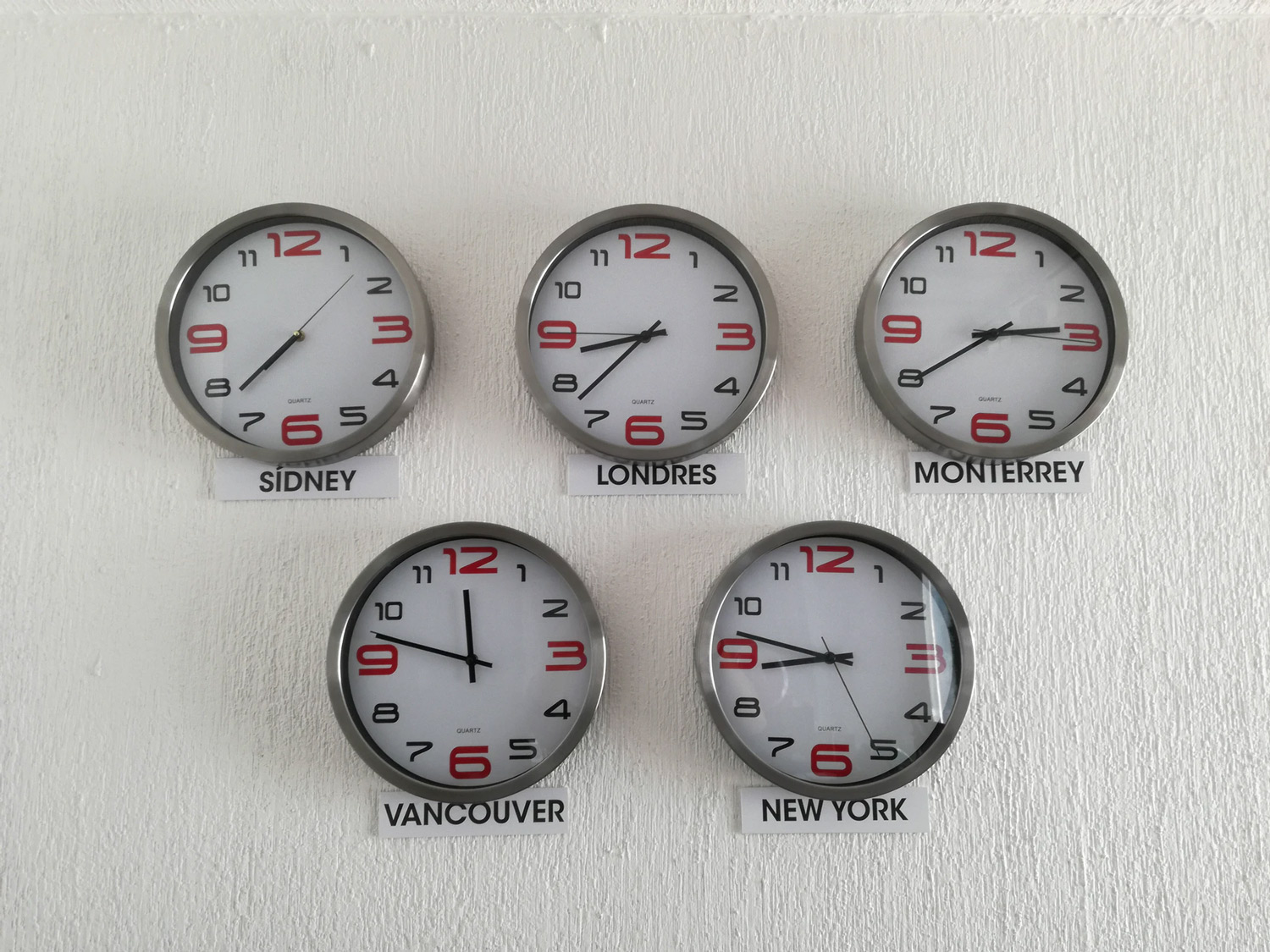Working Across Different Time Zones: Best Practices & Tools

Collaborating across different time zones can be a challenge for teams used to working in the same room or state.
But as we learned in our State of Remote Work Report (June 2021), more people want to work remotely than ever before. So you may soon see team members working across borders and time zones becoming the norm.
After all, having employees working in multiple time zones is like giving your company a 24-hour workday -- with the best talent in the world.
Teams can collaborate to meet deadlines without the need for overtime or late-night shifts. Employees in one time zone can hand off semi-completed projects for coworkers to finish in the next.
Basically, you can accomplish more without sacrificing quality. But only if you collaborate and communicate effectively.
So let’s talk about how to do that today.
Collaborating Across Different Time Zones: 5 Best Practices and Tools for Greatness
Follow these best practices whether you’re a remote company with a centralized HQ and time zone or a fully distributed company without either:
1. Establish Everyone’s Time Zone and Preferred Work Hours
When it comes to working with teams across different time zones, the number one rule is to be mindful, empathetic, and respectful.
No one should feel forced into an always-on mindset. If employees don’t create clear work boundaries, they risk burning out, which negatively affects the entire team’s productivity, creativity, and collaboration.
So to create healthy work-life boundaries for all team members:
Encourage employees to share their preferred work hours. One of the perks of working remotely is the ability to create your personal work from home schedule.
You’ll have early birds, night owls, and employees who fall somewhere in between. You may also have team members who like working split shifts, where they work part of the morning, take time off to run errands or pick up their kids from school, then continue working at night.
Whatever they choose, it’s important to respect everyone’s preferred work hours and do-not-disturb hours -- and know when these occur in their time zone. Share these with the team, so everyone knows when it’s okay to dish work and when it’s not.
Update your time zone in Slack. It’s impossible to keep track of everyone’s local time zone all the time. You’ll probably have a mix of remote team members working from home and digital nomads who travel to a new locale every three months.
Thankfully, message app Slack has your back.
Anytime your employees want to message each other, they just have to click “View Profile” to see what time it is where their recipient lives.

Take advantage of auto-responders like status updates in Slack or out-of-office emails. These can be used during off-hours, deep work sessions, or vacations to let employees know when they can expect a response.
Use a shared Google calendar (or something similar) to see when employees in other countries are observing national or religious holidays. Allow everyone to add their vacation and time off days here, so it’s easier to plan collaboration sessions while respecting local customs.
Keep a dialog open about work-life boundaries and communication windows. Employees should feel comfortable and safe discussing what’s helping or getting in the way of productivity.
This should all be discussed early on during your virtual onboarding process, along with this next tip:
2. Create a Communication and Collaboration Playbook
Guidelines for your communication policies and collaboration tools should be clearly outlined and shared during onboarding. Employees can read and refer back to these guidelines so they know what to do and what’s expected of them.
Your playbook should outline your:
Communication channels to use and when. Will employees have to show up for live video check-ins? Does your team like sharing resources via Slack or email? Get everyone using the same channels to keep conversations centralized, organized, and accessible.
Project management tools. Project managers like Trello, Basecamp, and Asana keep track of what everyone’s working on as it moves through the pipeline. And using one is a must-have for any team hoping to improve remote collaboration.
Team leaders can assign tasks here, add resources (like spreadsheets, mockups, slides, etc.), and set deadlines. Team members will know what they’re responsible for, pick up tasks seamlessly, and leave comments/updates for their coworkers to address during their shifts.
Everyone will have what they need to hit the ground running as soon as they clock in for the day, no matter when that happens to be.
3. Get Your Asynchronous Communication On Point
Asynchronous communication should be standard for remote teams, especially those with employees in different time zones.
Teams send each other messages without expecting an immediate reply. This allows employees to work autonomously, uninterrupted, and more productively. When employees have a break to check their messages, they can give each response the time and attention it deserves.
For remote teams to excel in asynchronous communication, they must:
Always plan ahead. Consider your team’s work hours and the time differences between them before sending messages, making requests, or setting deadlines. You may need to hand off tasks a day or two early in case they don’t get the message or start working on it until the next day.
Clearly communicate deadlines. It’s a good habit to explicitly state the deadline in your time zone and your teammate’s time zone to erase any chance of confusion. So, for example, “I’ll have that ready for you by Thursday, June 27, at 10 AM (EST) / 3 PM (BST).”
Emphasize well-written communication. Asynchronous communication requires people to write clear, complete, yet concise messages. People should have everything they need to get started on a task or request ASAP.
Why is this so crucial?
Let’s say you hastily send out a message that’s unclear or confusing. It could be another three to 16 hours before your recipient reads it during their work time. Then they’ll need to message you for clarification and wait until you return to work to reply.
An entire day (or more!) could pass without anything getting done by the time they see your second message and take action.

So before you send a message, ask yourself:
- Does my recipient have everything they need to complete the next step?
- Can I make anything clearer?
- Is there anything I can attach to facilitate work (such as spreadsheets, case studies, meeting memos, etc.)?
- Does my recipient have access to the resources I’m sharing?
Giving everyone what they need increases their ability to complete their work autonomously and without asking for help.
Consider creating a standardized set of emoji reactions, like the Arc development team. They designated specific emojis to mean “I’m finished working on that,” “I agree with your idea,” or “Let me think about it and get back to you.”
With one simple emoji, messages are clear and easy to understand at a glance. These also help when your teammates don’t all speak the same language.
4. Leave Room for Synchronous Communication
Synchronous communication, or communication that happens between teams in real-time, is still essential for team building, bonding, brainstorming, celebrating project milestones, and more.
So while 75% of your communication should default to asynchronous methods, leave 25% for synchronous communication like:
- Real-time video chats and Zoom meetings
- Watercooler conversations in Slack
- Shout outs and kudos
- Weekly check-ins
These moments will help tie your team together, making it easier to collaborate productively when remote. They also reinforce your company culture.

If you don’t have team members working in overlapping time zones, it’s almost impossible to get everyone to meet at the same time without inconveniencing someone. One employee will always have to wake up too early or stay online too late.
So it’s fair to rotate meeting times between time zones every month or quarter. This ensures no one team is constantly making the sacrifice to stay connected. And it may get everyone to start thinking twice about holding meetings when they’re the one clocking in odd hours.
5. Follow this 4-Step Meeting Protocol
To avoid the very real issue of Zoom fatigue, try to follow this protocol before you schedule another meeting:
1. Ask yourself, Does this really have to be a meeting? Real-time collaborating sometimes isn’t as productive as we like to think it is. So before you ask people to rearrange their schedule, make sure what you plan to discuss really warrants everyone being present.
2. Can you convey information better with a video recording? Tools like Loom and PingPong let you record video messages of yourself, your screen, or both.
You can share quick messages, explain new processes, or outline complicated concepts with your team sans real-time meetings. Everyone can view these on their own time, take notes, and refer back to your instructions or ask questions later.

3. Send out a meeting agenda to all team members in advance. This gives everyone an idea of what’s on the itinerary (to brainstorm ideas or questions before you meet) and keeps meetings on track.
Plus, setting a shared goal and outlining what you hope to accomplish are some of the best practices for leading effective virtual team meetings.
4. Record or take notes during the meeting to share with those who couldn’t make it. This keeps everyone in the loop without forcing anyone to cross their work-life boundaries.
Consider creating a buddy system here. A designated point of contact in one time zone will be responsible for sharing updates, information, feedback, meeting notes, etc., with a designated point of contact in a different time zone.
Collaborating Across Different Time Zones? Easy Peasy.
Collaborating across different time zones is easy when you follow the five tips outlined in this guide. Employees will be able to focus and contribute their all, work cohesively on tasks with their team, and reach shared goals.
It starts with establishing everyone’s preferred work hours, so you can communicate effectively without crossing anyone’s work-life boundaries. Next, you’ll want to make asynchronous communication the norm while leaving room for synchronous team-building.
Need more remote talent for your team? Post your remote job ad on itjobsfromhome.com, the largest remote work community in the world. You’ll find candidates who thrive on autonomous work and don’t require hand-holding to help your team get to the next level.
Ready for a new challenge? If your current team doesn’t know how to collaborate across time zones, it may be time to look for one that does. Subscribe to the newsletter on itjobsfromhome.com's homepage for the latest remote job listings!